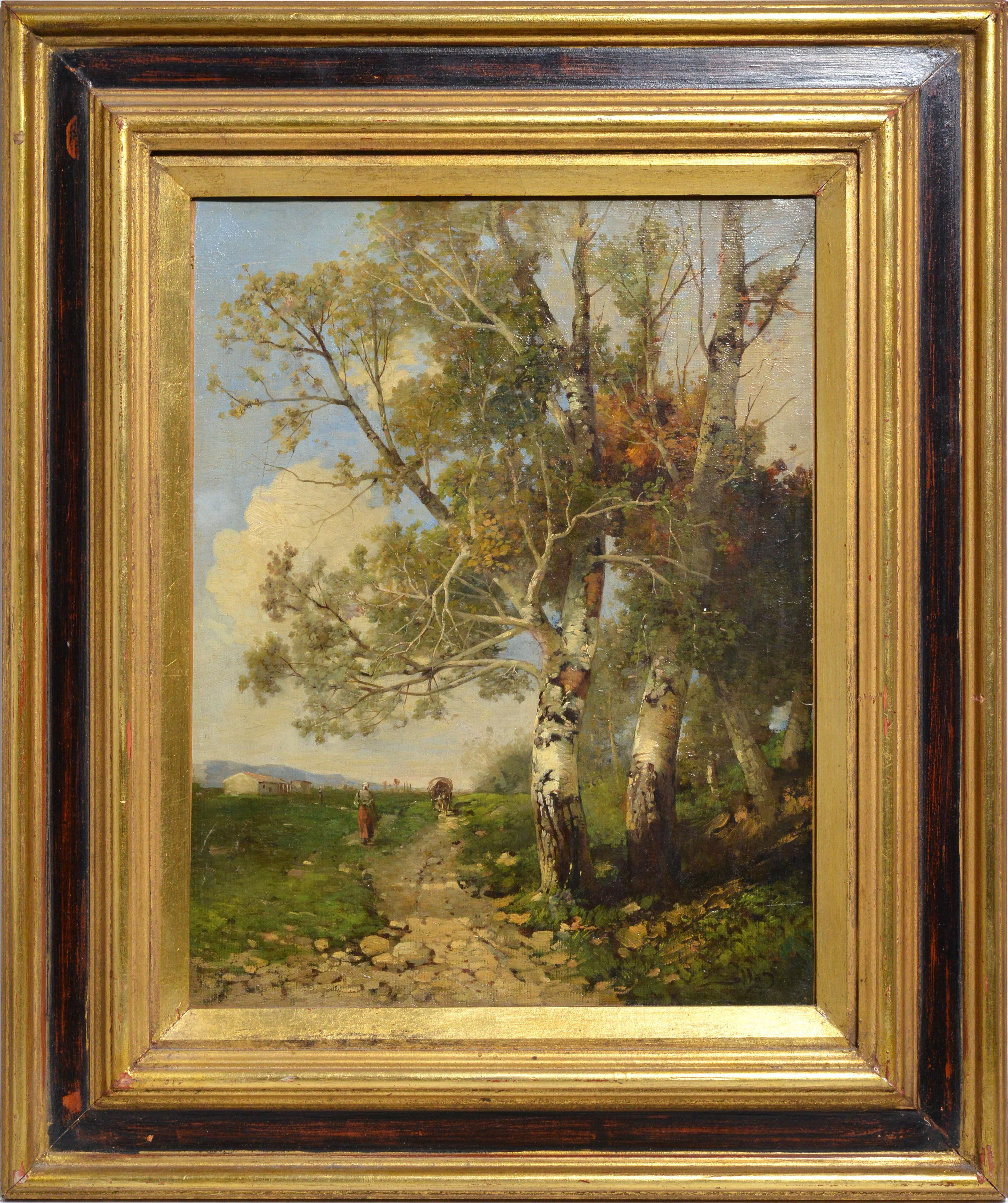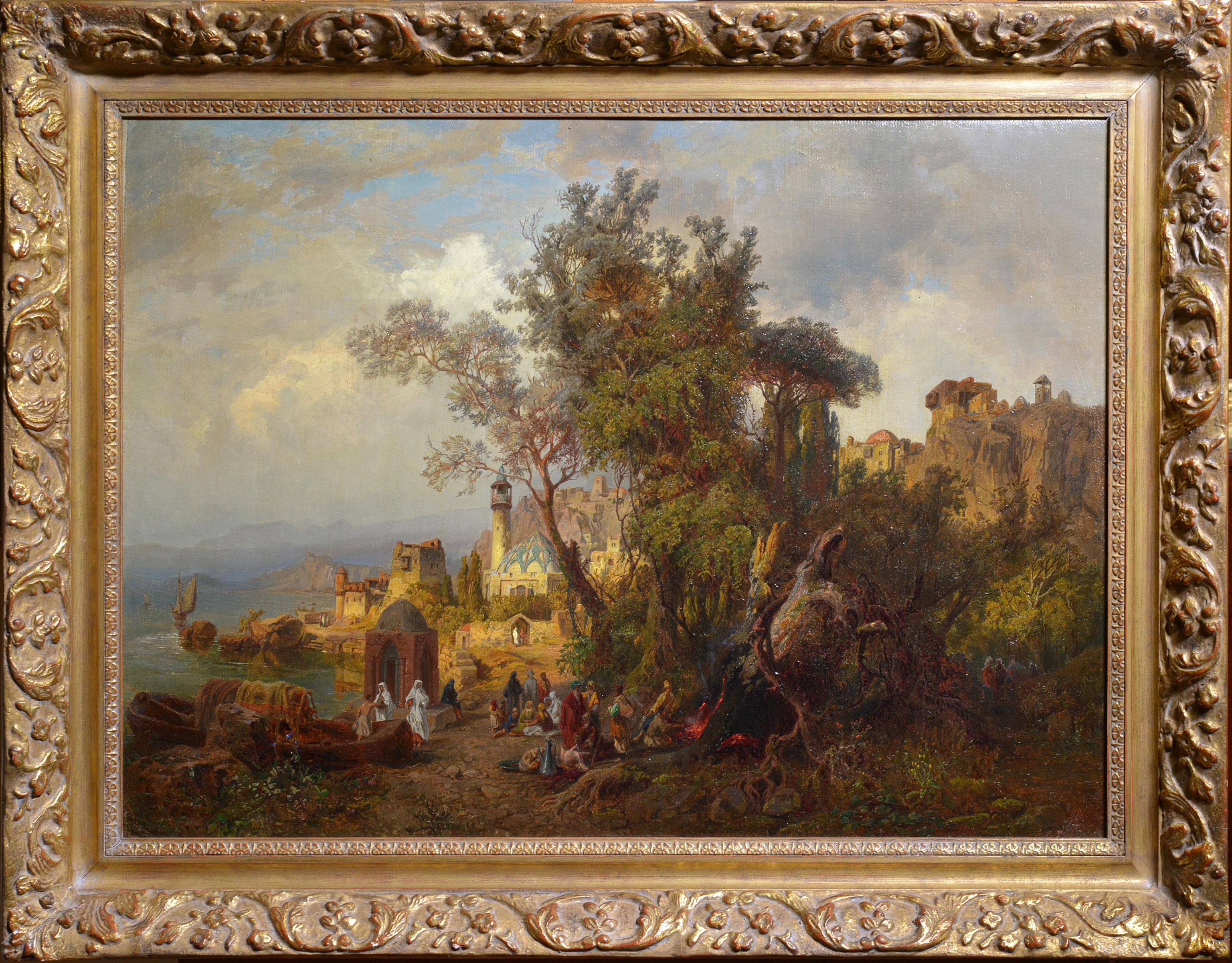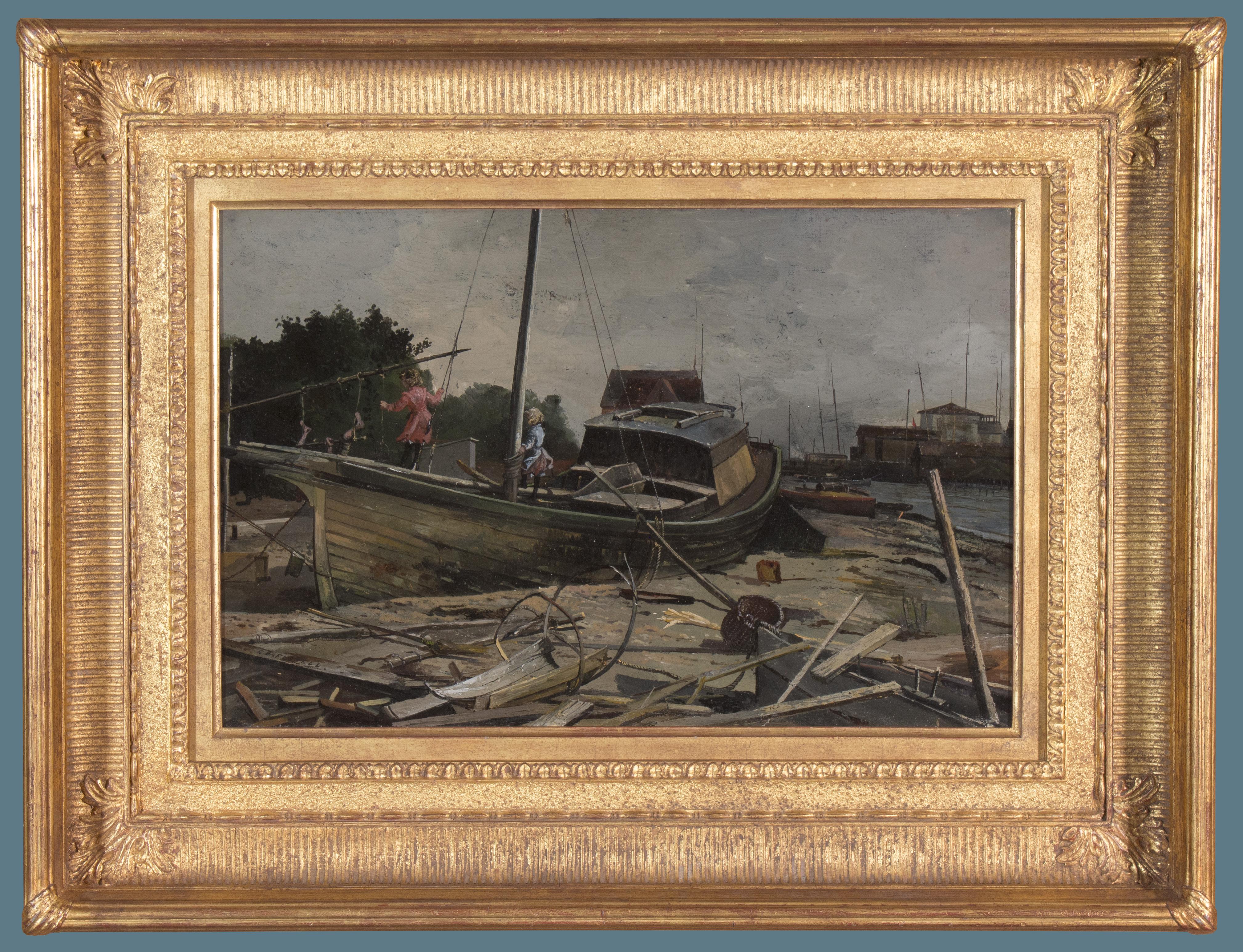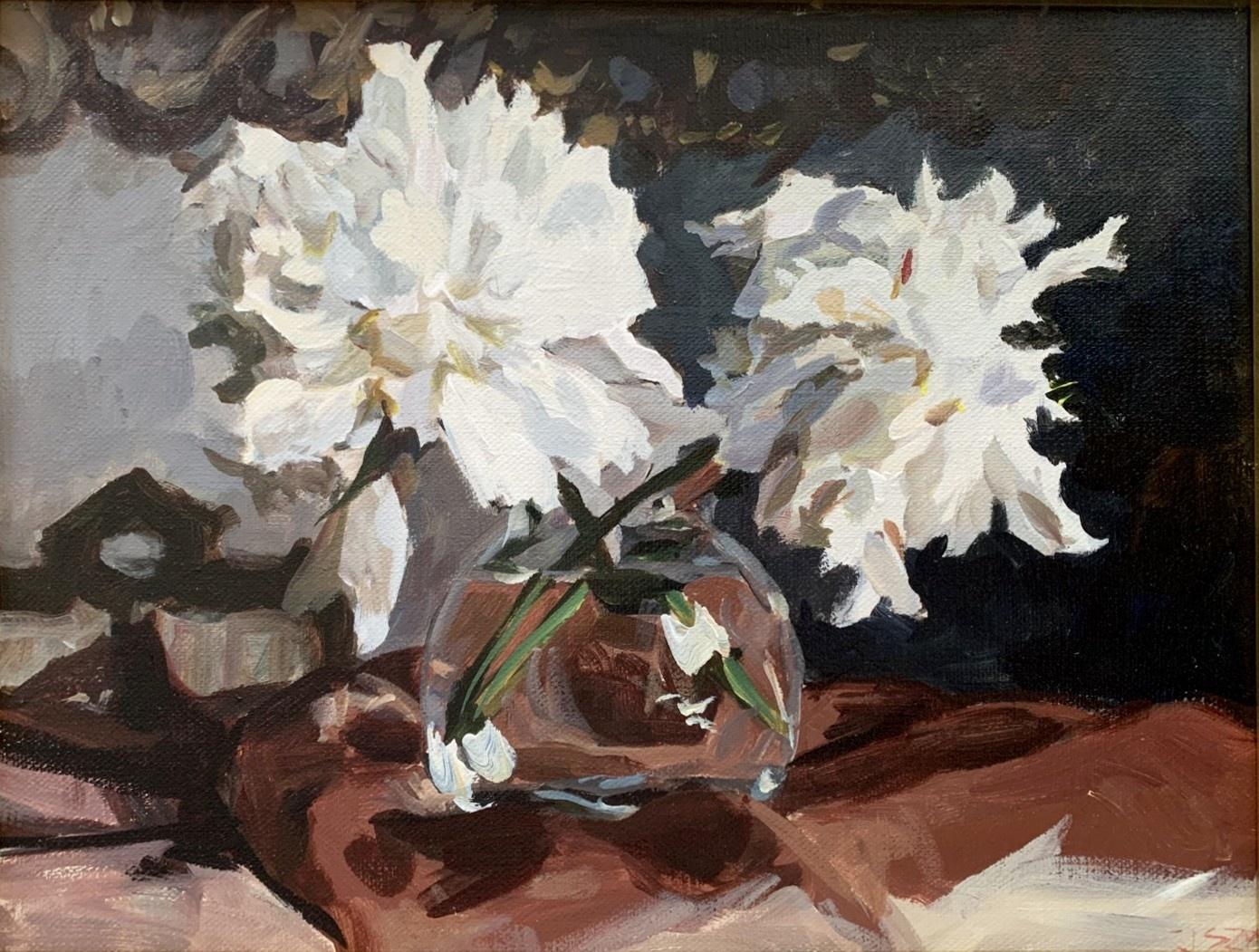Items Similar to "Venetian Canal" Late 19th Century Oil on Canvas by Spanish Artist Antonio Reyna
Want more images or videos?
Request additional images or videos from the seller
1 of 14
Antonio Reyna Manescau"Venetian Canal" Late 19th Century Oil on Canvas by Spanish Artist Antonio ReynaCirca 1900
Circa 1900
About the Item
ANTONIO REYNA MANESCAU
Spanish, 1859 - 1937
VENETIAN CANAL
signed & located "A. Reyna, Venezia" (lower left)
oil on canvas
11-1/2 x 19-3/4 inches (29 X 50cm.)
framed: 17-1/4 X 25-1/4 inches (43.5 X 64 cm.)
PROVENANCE
Private Collector, Madrid
Reyna was considered the most notable representative of Venetian vedutism of the 19th century. He traveled to Venice in 1855 and was totally impressed by the beauty of the place, and from that moment on, Venice will be the inexhaustible framework of his work.
It is this beautiful Venetian view we observe its bold light brushstroke, a skillful composition that makes us enjoy the perspective of one of the Venetian canals with its palaces on the sides of its channel and a small bridge in the distance. The small gondolas at rest on the calm waters of the canal gives us a pleasant sensation of tranquility.
Its chromatic richness and the ease of its brushstroke complete the beauty of this work.
Antonio Reyna Manescau (5 December 1859 - 3 February 1937), was a Spanish painter that developed most of his career in Italy. A member of the Málaga School of Painting, he studied under Bernardo Ferrándiz and alongside Moreno Carbonero. He moved to Italy in his early 20's, where he was further influenced by Italian and Spanish expatriate artists, and where he lived for the rest of his life.
After his first visit to Venice in 1885, he specialized in landscape painting. He is widely known for the preciosity of his Venetian vedutas, the importance he places in the accurate depiction of architectural detail and his mastery of color. Among his most important works are his numerous views of the Venetian canals and Piazza San Marco.
Born in the town of Coín (Málaga), he was one of ten children (six of which died in childhood) of Francisco Reyna Zayas (1825-1892) and Matilde Manescau y Otsman (1823-1910). His parents enjoyed a good social standing, being his uncle José Reyna Zayas mayor of Coín while Antonio was a child
Being still a little boy Antonio showed a great ability for drawing. Although he continued living in Coín for the rest of his childhood, he began his artistic training at the School of Fine Arts in Malaga, where he was taught by Joaquín Martínez de la Vega, first, and then by Bernardo Ferrándiz, founder of the Málaga School of Painting. He studied alongside future master José Moreno Carbonero, who was just a year older than him. From a young age he exhibited his works regularly, standing out in the local artistic environment for his use of colors, the attractiveness of his compositions and the agility of his brushwork. In 1880, at age 20, he sold his first important work for the town hall of Coín.
In 1882 he received a scholarship from the Provincial Council to further his art studies in Italy. He moved to Rome (where he was to live until his death), and in 1885 visited Venice; from that year on, Venetian landscapes, showing landmarks like the Grand Canal and Piazza San Marco but also less known quarters of the city, are ubiquitous in his work. Venice was at that time an artistic hub for Spanish painters, thanks in part to Fortuny's widow residing there, and also because of the Venetian production of Villegas Cordero and Martín Rico, whose preciosity in the depiction of the landscape was adopted by Reyna Manescau.
Although his scholarship was supposed to finish in 1886, he was captivated by Italy and remained there. In Rome he frequently visited the workshop of Villegas Cordero, like so many other Spaniards, and under his influence he produced some oriental paintings. At the same time, as a member of the Spanish colony, he was a regular in tertulias in the Café El Greco. In 1889 he married the opera singer Beatriz Mililotti Desantis, then 20, and settled to live in Rome.
Canal in Venice. Museum of Fine Arts, Boston.
Influenced by classical antiquity, by the mid 1880s he painted his lost masterwork Floralia, a classical scene that represents the annual festival celebrated in honor of the mythical goddess
Reyna Manescau's works are represented at museums such as the Boston Museum of Fine Arts, the Hermitage Museum, the Carmen Thyssen Museum and the Málaga Museum, and are also present in various private collections.
- Creator:Antonio Reyna Manescau (1859 - 1937)
- Creation Year:Circa 1900
- Dimensions:Height: 11.42 in (29 cm)Width: 19.69 in (50 cm)
- Medium:
- Movement & Style:
- Period:
- Condition:
- Gallery Location:Madrid, ES
- Reference Number:1stDibs: LU128115176552
About the Seller
5.0
Vetted Seller
These experienced sellers undergo a comprehensive evaluation by our team of in-house experts.
Established in 1977
1stDibs seller since 2019
21 sales on 1stDibs
Typical response time: 2 hours
- ShippingRetrieving quote...Ships From: Madrid, Spain
- Return PolicyA return for this item may be initiated within 14 days of delivery.
More From This SellerView All
- Feria de SevillaLocated in Madrid, ESJOSÉ CAÑAVERAL Spanish, 1833 - 1894 FERIA DE SEVILLA signed "JCañaveral / Sevilla 1881." (lower right) oil on canvas 29-1/3 x 19-1/2 inches (74.5 x 49.5 cm.) framed: 38-1/2 x 29-1/2 ...Category
1880s Realist Figurative Paintings
MaterialsCanvas, Oil
- "Ca' d' Oro, Venice" Late 19th Century Oil on Canvas of Venice, by Antonio ReynaBy Antonio Reyna ManescauLocated in Madrid, ESANTONIO REYNA MANESCAU Spanish, 1859 - 1937 CA' D' ORO, VENICE signed & located "A. Reyna, Venezia" (lower right) oil on canvas 11-1/2 x 19-3/4 ...Category
1890s Realist Landscape Paintings
MaterialsCanvas, Oil
- "Filipino Girl Coming Down the Steps", 19th Century by Artist Fabian de la RosaLocated in Madrid, ESFABIAN DE LA ROSA Filipino, 1869 - 1937 "FILIPINO GIRLO COMING DOWN THE STEPS" signed & dated "F. de la Rosa, 1894" (lower right) oil on canvas 42-3/4 x 23-3/4 inches (108 x 60...Category
1890s Realist Figurative Paintings
MaterialsCanvas, Oil
- "Filipino Farm Workers in Horse Carriage" 19th C. Oil on Canvas by F. de la RosaLocated in Madrid, ESFABIAN DE LA ROSA Filipino, 1869 - 1937 FILIPINO FARM WORKERS IN HORSE CARRIAGE signed & dated "F. de la Rosa, 1894" (lower left) oil on canvas 42-3/4 x 2...Category
1890s Realist Figurative Paintings
MaterialsCanvas, Oil
- "Place de la Concorde", 19th Century Oil on Canvas by Artist Joaquín PallarésLocated in Madrid, ESJOAQUÍN PALLARÉS ALLUSTANTE Spanish, 1853 - 1935 PLACE DE LA CONCORDE signed & located "J. PALLARÉS / París." (lower right) oil on canvas 13-1/4 x 18-...Category
1890s Realist Figurative Paintings
MaterialsCanvas, Oil
- "Far Away Thoughts", 19th Century Oil on Canvas by Daniel HernándezLocated in Madrid, ESDANIEL HERNÁNDEZ Peruvian, 1856 - 1932 FAR AWAY THOUGHTS signed "Daniel Hernandez" (lower right) oil on canvas 27-1/2 x 19-1/4 inches (70 x 49 cm.) framed: 39-3/8 x 31-1/8 inches (100 x 79 cm.) Daniel Hernández Morillo...Category
Early 1900s Realist Figurative Paintings
MaterialsOil, Canvas
You May Also Like
- Ship Leaving the Bay at Sunrise French Seascape 18th century Rococo Oil PaintingLocated in Stockholm, SEAttributed Charles François Grenier de Lacroix or Charles - François Lacroix de Marseille (1700 - 1782) as signed lower left on the stone “Lacroix”. The scene of the departure of nobles on a ship, somewhere among the Mediterranean landscapes at sunrise. Lacroix's sense of color and attention to detail are particularly impressive: the sea is calm, the sun is rising and as a soft pink hue begins to emerge in the clouds, the morning haze has not yet cleared and the air is clear and clean, large ship...Category
Late 18th Century Realist Landscape Paintings
MaterialsCanvas, Wood, Oil
- Summer Landscape with Birches by Austrian Master Gollob Early 20th century OilLocated in Stockholm, SEHeinrich Gollob (1886 - 1917) - Austrian painter. Gollob's attention to detail demonstrates his talent for bringing landscapes to life through vibrant colors, textures and the play o...Category
Early 20th Century Realist Landscape Paintings
MaterialsCanvas, Wood, Cotton Canvas, Oil
- Evening on River German Master Caucasian Panoramic Landscape 19th centuryLocated in Stockholm, SEAttributed Paul Von Franken (1818-1884), famous Gemany a genre and landscape painter, signed bottom right. Fertile scenery coastal town with castle, mosque, minaret, large travelers ...Category
1850s Realist Landscape Paintings
MaterialsCanvas, Wood, Oil
- Installation of the Liberty Bell at Independence Hall, PhiladelphiaLocated in Philadelphia, PALouis Roberts Dougherty (American, 1876-1948) Installation of the Liberty Bell at Independence Hall in 1754, c. 1915 Oil on canvas, 34 1/2 x 24 3/4 inches; Framed: 43 1/2 x 33 3/4 i...Category
Early 20th Century Realist Landscape Paintings
MaterialsCanvas, Oil
- Children Playing on a Boat, likely New York/Brooklyn/Flatbush Area, c. 1895Located in Philadelphia, PACharles Lewis Fussell (American, 1840–1909) Children Playing on a Boat Oil on canvas, 11 x 16 3/4 inches Framed: 19 x 25 inches (approx.) Signed at lower left: “C.L. Fussell” Charle...Category
1890s Realist Landscape Paintings
MaterialsCanvas, Oil
- Peonies - Contemporary Still life Oil Painting, Realism, Polish artBy Janusz SzpytLocated in Warsaw, PLJanusz Szpyt was born in 1960, he is a Polish painter. He graduated from the Graphic design faculty and painting from the Academy of Fine Arts in Krakow. ...Category
2010s Realist Landscape Paintings
MaterialsOil, Canvas
Recently Viewed
View AllMore Ways To Browse
Antique Spanish Art
17 Century Spanish
Ten Works By Ten Painters
Spain Old Masters
Old Spanish Master
19th Spanish Painting
Mid Century Venetian Art
19th Century Spanish Paintings
Antique Finish Painting
Italian Late 19th Century Oil
Spanish Old Master Paintings
Landscape Realist 19th Century
Venetian Drawings
Venetian Painter
Venetian Oil Canvas
Venetian Landscape Paintings
Death In Venice Painting
Oil Canvas Italian Landscape 19th





